How to Boost Sales by Selling to Existing Customers
Want to increase your revenue?
Who am I kidding, of course, you do!
The most obvious way to go about doing this is to go out and acquire new customers.
But did you know you can increase your revenue by focusing on the customers you already have?
Without acquiring a single new customer?
Acquiring new customers is great, but retaining customers and focusing on getting your existing customers to buy more from you is better.
But in doing so, we cannot neglect the importance of acquiring new customers as well.
When your customer acquisition works together with your customer retention, that’s when you have a recipe for success.
If you’re only focusing on increasing your sales without acquiring new customers, eventually you’ve lost a large part of your existing customer base because of several natural reasons.
In other words, you cannot solely depend on your existing customers.
Focusing on your existing customers have many benefits.
Not only does it help you achieve your goal of increasing your revenue, but it also saves you time, effort, resources, and most importantly money.
Acquiring customers is expensive, but you probably know that already.
If you’re spending all your money on acquiring new customers with marketing methods that aren’t giving less than impressive results, it can quickly drain your budget.
In fact, even if you’re using marketing methods that have proven to drive great results at a low ROI, but not putting any resources towards how you’re going to retain them and get them to buy from you over and over again, it’s like filling a glass of water with holes in it.
If you stop pouring, you’ll run out.
But if you’re spending half of the efforts you’re spending on acquiring customers, and the other half on fixing those holes, you can see how you have a winning concept.
In this article, we’ll look at how you can increase your revenue – without acquiring new customers.
Sounds impossible?
Let’s dig in and see that it is actually is possible, and how it can help you drive more revenue than when you’re only focusing on customer acquisition.
How to boost sales without acquiring new customers
Acquiring new customers is expensive.
In fact, it is 6 to 7 times more expensive to acquire a new customer than it is to keep a current one.
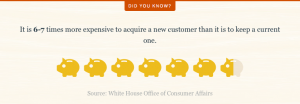
That’s quite significant.
But that’s not all…
In fact, loyal customers, customers you retain, are worth up to 10 times as much as their first purchase.
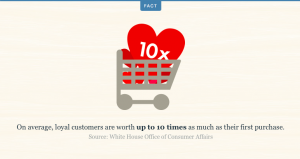
What’s more, the proof
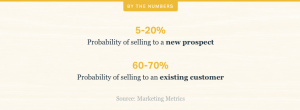
The bottom line is that retained and returning customers spend a lot more than new customers, and at the same time, it is a lot cheaper to keep customers that have already bought from you than it is to attract new ones.
When looking at these statistics, it feels stupid to do anything else than focus on your existing customers to increase your revenue, but because you’ll lose customers no matter how great of a service you give them, and no matter how much you show your appreciation, you will lose customers along the way, and this is why you cannot solely depend on the customers you have.
But acquiring customers is a completely different story and not something we’ll focus on in this article.
The best part is that it is a lot easier to retain a customer than it is to acquire new ones.
Your existing customers are already well aware of your brand, they’ve tried your products, they’ve experienced what it is like to buy from you, they don’t need to be convinced about your brand once more because they’ve already been convinced once.
In the words, they’ve already gone through the different stages of your sales funnel.
The only difference between brands who are focusing on increasing revenue without acquiring new customers and those that solely focus on increasing revenue by acquiring new customers is that they view the sales funnel with a set of traditional eyes or modern eyes.
Because the traditional sales funnels look like this:

While the modern looks like this:
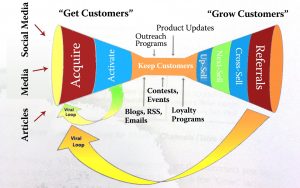
which factors in how you’re going to retain your customers. Not just abandon them once you’ve got them to convert.
The modern sales funnel realizes the value of focusing on customer retention.
The only caveat of an existing customer is if they have had a terrible experience with your brand, of course.
But even then, it is not impossible to retain your customer.
The bad news is that if a customer has had a bad experience, they’ll never do business with you again 91% of the time.
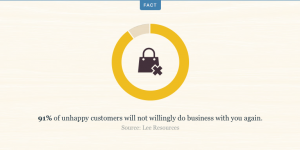
But on the flip side, if you resolve your customer’s complaint, and make things right again, they will do business with you again 70% of the time.
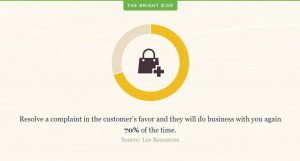
This is great news because it means that even if you have messed up, you can make things right again, and get your customer to stay with you.
Unfortunately, not all businesses realize this, and so if they’ve messed up, they give up, and completely ignore the customer, in the belief that it is hopeless anyway.
But what will end up happening then is that the customer will get even more disgruntled and angry.
The worst part about this is that they’ll tell their peers.
A lot of them.
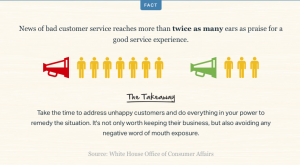
Chances are, you’re here because you think the journey of acquiring customers is long and expensive.
And that it isn’t working very well.
You’re not alone.
Luckily, you’re also in the right place.
If the traditional way of increasing your revenue isn’t working for you, it’s time to focus on your existing customers and implement a new strategy.
Improve your customer experience
The customer journey is everything.
People want to get from A to B as quickly and with as little effort as possible.
This goes for everything, especially buying from you.
It’s no secret that if the process of buying something is super long and annoying, the majority of people will leave and never look back.
Chances are, you’ve done the same thing when shopping online,
So if your store is set up that way, why wouldn’t your customers do the same?
This goes for both new and existing customers.
But remember that just because they are returning to you doesn’t mean they’re completely satisfied.
They might just stay with you because they don’t have a better alternative, or because they feel familiar and they trust your brand.
But what if a competitor comes up with a better system?
The foundation for retaining your customers is always optimizing and looking to approve the customer experience with your brand.
From entering your website to putting a product in their shopping cart and checking out.
If you ask your customers to fill in their age, their sleeping habits, how often they eat, what they dream of, and more nonsense questions, eventually your customers will lose patience and abandon their cart.
This is why many customers never get past the checkout.
If your checkout looks like this, where you force your customers to first log in before they can type in all their order information, you’re doing something wrong.
And you’re probably seeing more abandoned carts than you need to be seeing
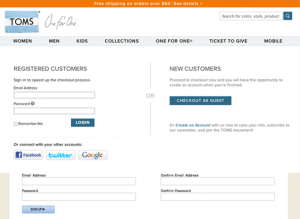
Remember that just because your existing customers have had the energy to make it through your checkout page once, doesn’t mean they are willing to complete it over and over.
Believe it or not, but it is actually in your checkout where the largest drop-off of customers takes place.
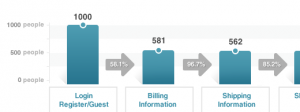
Your customers want to have a better customer experience.
Even if they are sticking around, they might still say that about your brand.
But don’t for one second believe that they’ll stick around forever.
Or even stick around after their first purchase.
This is why customer experience plays a crucial role in customer retention and returning customers.
In fact, Eighty-eight percent of consumers said they would pay more for a better customer experience.
Identify areas of the customer journey to improve
All brands have areas where they can improve their customer journey.
However, the problem is that brands have a hard time identifying the problems and issues their customers have.
This is why it is crucial to invest a ton of time and energy into learning more about your customers and the problems they’re facing.
Doing this is helpful not only to improve the journey your customers have, and as a result get them to return, but also to identify problems which new products of yours can solve.
Almost like a market research.
For now, though, we’ll focus on the customer journey.
The key to finding out what your customers are thinking is to ask and to listen.
Common approaches are to:
- Ask your customers
- Create surveys
- Give your customers the opportunity to leave reviews
When doing this, ideally you should be giving back your customers something for taking the time to provide you with valuable feedback.
Because they’re giving you the most valuable thing you can give someone, but what are you giving them?
The sad part about this is that many brands are terrified of customer reviews.
They’re afraid that if customers write something, they’ll complain, and as a result scare away the new potential customers.
And this is true.
But only if you don’t do something about it.
See negative reviews as something positive.
Because 30% of consumers assume online reviews are fake if there are no negative reviews.
But what’s even more important is that when your customers complain, they’re complaining because they care about your business and want to see that you actually do something about it to help you improve.
Most of the time, the people who are complaining are loyal customers who want to continue being customers of your brand.
But if you’re not doing something about the thing they’re complaining about, they might not have another choice than to leave you.
For every customer who complains, there are 26 customers who don’t say anything.
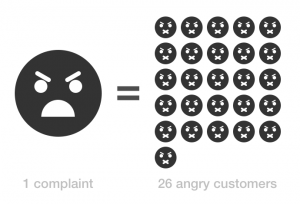
So take the time to actually listen to what people are complaining about.
Because most often, what they are saying actually holds truth to it, and if it does, chances are, there are a lot more people who are experiencing the same problem.
Unfortunately, this means that you can lose a lot of your existing customers as a result.
Without realizing it before it is too late.
The best way to identify problems your customers might have is to put yourself in their shoes.
If you sell a product, go through the ordering process on your website and look at it with critical eyes.
What’s more, put your product to the test by using it in all types of ways that you can imagine your customers using it.
Improving the customer journey can be everything from making your website load faster to making the return experience a real pain.
I’ve seen tons of brands making it super easy to order, but tremendously difficult to return something, and in theory, it’s an amazing idea.
Get people to buy from you, but make it close to impossible to return things.
Genius.
The only problem with this is that if you make it difficult for people to return something, there’s a great risk they’ll become angry at your brand, and you’ve just lost yourself a potential loyal returning customer.
Leveraging cross-selling and upselling
If you want one method to increase your revenue by leveraging existing customers, this is it.
You can significantly increase your revenue by increasing the order value of your current customer every time they purchase from you.
It’s not always about gaining more customers to increase revenue, but getting your existing customers to spend more.
Getting your existing customers to spend more is almost always more profitable than acquiring new customers, considering how expensive it is
Doing so is called upselling or cross-selling.
Upselling means that you’re encouraging customers to buy something similar to the thing they’ve already purchased, but now, you’re selling something more expensive.
For instance, If I visit
Cross-selling means that you’re encouraging your customers to buy something that will complement the thing they’ve just bought.
The latter is almost always present in every single clothing store online.
Just look at H&M’s checkout
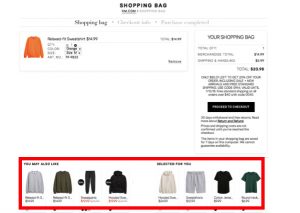
When I am in the checkout for a sweater, they suggest pants that complements my purchase of sweater. They also present similar sweatshirts that I might like, considering the product I am about to buy.
The best part is that you can do this no matter what product you are selling, and what industry you’re operating in.
As your customers become more loyal and return to your brand, they tend to buy more from you.
With upsells, you can boost this number even higher.
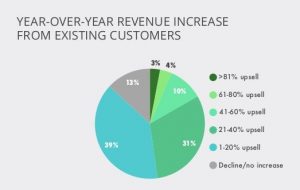
You should also remember that the more products someone buys from your brand, and the more times they buy from you, the more loyal and engaged they’ll become in your brand.
Or, if you look at it from another angle, as your customers buy more things for you, they become more loyal.
But either way, if you can upset your existing customers, you can make them even more loyal, and significantly increase the chances of them returning to your brand.
Increase customer loyalty
Loyalty is a crucial part of getting return customers.
Note that there’s a difference between having returning customers and having loyal customers.
Having customers return to your business might just mean that you’re in the right place at the right time.
But if a brand that is even more convenient, affordable, and just overall better, comes up, a consistent customer will jump to that business instead.
A loyal customer, on the other hand, will stay with you, even if another brand that is more convenient comes up.
Understanding the difference between loyal customers and returning customers is important because it prevents you from kicking your feet back and feeling safe in the belief that your customers will never abandon you – even if they will as soon as a better alternative to your brand comes up.
The key to making your customers loyal is giving them something your competitors can’t give you, and therefore give them a reason to stay.
If a customer buys groceries at the same store every day, don’t take for granted that they’re loyal.
It might just be that the grocery store is the closest to their home.
But if a store opens up a few minutes closer to their house, and they still continue to shop at the store they’ve always purchased from because they have a customer loyalty card, they stay because they have a reason to do so:
the loyalty card.
The competition is tremendously tough in most industries, and usually, the competitors in an industry that are all fighting for the same customers have very similar products, and there’s little that separates them from each other.
One might be a little cheaper than the other, the other might have wider assortment.
But what often separates these businesses apart is the relationship they have with their customers, and the loyalty they can get their customers to establish in them.
Because when they do, they make sure that their returning customers will be very unlikely to buy from their competitors, except for a few exceptions.
The reason?
They’ll feel guilty that they’re abandoning the brand they’re loyal to in exchange for a competitor.
Kind of like cheating but in business.
So how can you increase customer loyalty?
Well, there are obviously many ways to make your audience more loyal, and we’ll go more into some of them further on.
To master the subject, read How to Make Your Customers more Loyal (And Engagement on Social Media More Exciting).
Engage with your social media audience
When I get the question of what you can do to succeed on social media, I say engage with your audience.
That’s because it’s such an important part of the customer and audience relationships.
But the truth is that engaging with your audience isn’t just effective in growing your audience on social media, but it is also a tactic you should embrace if you want to succeed in business.
The only reason you’re going to use social media is that it is such a tremendous tool for reaching and interacting with your audience.
Never in the history of this earth has it been easier for brands to reach and engage with their audience on a regular basis than with social media.
Therefore, leveraging social media to engage with your audience is something all brands should do.
When you engage with your audience, you’re making them more engaged in your brand, and ultimately also more loyal.
The best part is that having a strong relationship with your customers gives them a reason to return.
In fact, relationships are one of the strongest and most powerful factors in convincing your audience to stay with your brand.
Think about it:
What are you willing to do for your wife, husband, mom, dad, or any other person that means much to you?
A lot, right?
While it is impossible to get to the position of having the same relationship with your customers as they have with some of the individuals mentioned above, just working to improve your relationship will do a lot for your brand because they’ll have a very good reason to stay with your brand and remain loyal.
When engaging with your social media, you want to take every opportunity you get.
Here are some basic approaches you can take to improve your customer relationships on social media, as well as a complete guide to doing so:
How to Improve Customer Relationships On Social Media That Boost Customer Retention
- Respond to your audience’s comments
- Ask questions
- Send messages
- Always respond to complaints
- Respond quickly
- Have one-on-one conversations
Greatly emphasize customer service
Bad customer service is the main reason brands lose customers.
And don’t for one second believe that just because a customer is loyal to your brand, they won’t abandon you if they have a bad experience with your brand.
Sure, they might be able to look past one negative experience, but maybe let you know about it, in the way I mentioned in the beginning of this article.
But if they feel like they aren’t listened to, if they feel like you’re just seeing them as a pain, and aren’t taking them seriously, there’s a great reason they’ll leave you.
If a loyal customer values your brand, but you are clearly not valuing them, why would they continue to be loyal to you if they don’t get any respect in return?
$62 billion dollars.
That’s the amount of money that businesses lose every year because of lost customers as a result of bad customer service.
I don’t know about you, but I’d love to have a cut of those $62 billion.
Customers generally have a very low patience.
If they have a bad experience, many people will leave right on the spot without saying a word.
Other people might write to you and let you know about the problem, and then leave you if they feel like you aren’t really solving the problem, or helping them in a good way.
Apart from the checkout, lack of great customer service is the area where most brands lose customers.
And there are many areas where brands fall short in providing their customers a great customer service.
One of them is time.
In fact, according to a study by SproutSocial, customers expect brands to respond within 4 hours. But the reality is that brands respond within an average of 10 hours on social media.
Ouch.
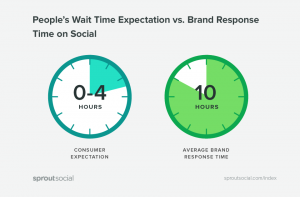
When it comes to social media, it has opened up completely new doors when it comes to social media.
Sure, customers expect brands to respond, on average, quicker on social media than on other channels, but with the quickly evolving and moving landscape of the internet, brands need to respond quickly to their customers.
If you don’t, there’s a great risk you’ll lose your disgruntled customer forever.
Or, even worse, go around telling all of their friends how bad you are.
And if that happens, you’ll not only lose loyal customers, but your reputation will also get damaged.
I mentioned earlier that 91% of customers will never buy from you again if they have had a negative experience with your brand, but if you succeed in resolving a customer complaint, they’ll buy from you 70% of the time again.
This just shows the tremendous power of great customer service.
And remember that among that 70%, you might have loyal customers who after all this time decide to leave you.
Losing loyal customers is the worst because loyal customers tend to spend more on your brand than new customers.
By focusing on providing great customer service, you can retain your customers, decrease the number of people who abandon your brand as a result of a bad experience and ultimately increase your revenue by limiting the number of lost customers.
And when you lose fewer customers you’ll have to spend fewer resources into acquiring new customers, which saves you money in the long run.
Conclusion
The main believe is that in order to make more money, you need to acquire more customers.
But when that happens, you’re missing what’s right in front go you: your existing customers.
By getting your existing customers to spend more, you can boost your revenue, but do so with less effort, and by spending less money.


